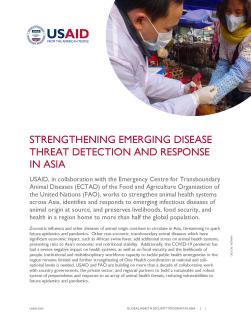USAID, in collaboration with the Emergency Centre for Transboundary Animal Diseases (ECTAD) of the Food and Agriculture Organization of the United Nations (FAO), works to strengthen animal health systems across Asia, identifies and responds to emerging infectious diseases of animal origin at source, and preserves livelihoods, food security, and health in a region home to more than half the global population.
Zoonotic influenza and other diseases of animal origin continue to circulate in Asia, threatening to spark future epidemics and pandemics. Other non-zoonotic, transboundary animal diseases which have significant economic impact, such as African swine fever, add additional stress on animal health systems, presenting risks to Asia’s economic and nutritional stability. Additionally, the COVID-19 pandemic has had a severe negative impact on health systems, as well as on food security and the livelihoods of people. Institutional and multidisciplinary workforce capacity to tackle public health emergencies in the region remains limited and further strengthening of One Health coordination at national and sub-national levels is needed. USAID and FAO are building on more than a decade of collaborative work with country governments, the private sector, and regional partners to build a sustainable and robust system of preparedness and response to an array of animal health threats, reducing vulnerabilities to future epidemics and pandemics.
ONE HEALTH COORDINATION & COLLABORATION
Effective coordination and collaboration among national and regional stakeholders are key to ensure the functionality and implementation of a national One Health system. Linking key ministries across human, animal, and environmental health, as well as other relevant stakeholders builds a common purpose, creating a unified vision and a functional One Health approach. Through USAID support, rapid identification of emerging infectious diseases and rumor tracking across government departments are facilitating earlier threat detection and containment.
IMPROVING ONE HEALTH WORKFORCE CAPACITIES
Through country level assessments and a targeted approach, USAID and FAO are building epidemiology and laboratory diagnostic capacities, establishing guidelines and protocols, training disease detectives through advanced in-service programs, and ensuring the region is equipped to identify existing--and newly emerging--disease threats at source in animal populations.
ENHANCING PREPAREDNESS AND RESPONSE
Robust surveillance systems are an essential component of early and effective response to zoonoses, which are diseases caused by pathogens that spread from animals to humans, and other emerging infectious diseases. By embracing a systems approach to strengthen early warning and surveillance capacities, countries across the region are advancing capacities to detect both zoonoses that threaten human health and animal diseases that threaten economic and nutritional stability.
REDUCING DISEASE RISK ALONG ANIMAL PRODUCTION VALUE AND SUPPLY CHAINS
Zoonotic influenza and other emerging infectious diseases transmit through animal production and trade value chains, from farm to market. Deepening our understanding of these supply and value chains inform effective risk reduction strategies. Through USAID support, applied research is helping us learn what does and does not work in preventing transmission, facilitating development of country specific solutions to reduce risks of introduction, spill over, and spread of zoonotic diseases.


